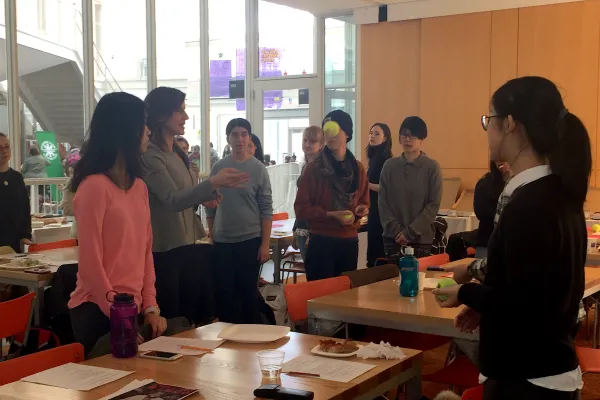Making Connections: The Art of Small Talk and Networking
Events

Published February 28, 2017
Leadership expert Rachel Simmons had some questions for the roomful of Smith students gathered for a workshop earlier this month in the Campus Center: “What is our anchor?” she asked them. “What are some shared observations we can all make right now?”
“This pizza,” one student offered. “The snowstorm from yesterday,” another chimed in. “The Campus Center,” said a third.
Students were trying to find a conversational “anchor” or light observation that could help them connect with each other. The activity was part of a February 10 workshop “The Art of Small Talk and Networking,” hosted by Simmons, a leadership development specialist for Smith’s Wurtele Center for Work and Life.
Simmons said she decided to offer the workshop—which was co-sponsored by Smith’s Lazarus Center for Career Development—to help students think on their feet. The small-talk workshop focused on teaching Smithies how to effectively network through conversation.
While students are often told that they should be networking, Simmons said, they are rarely taught the crucial role that small talk plays in making connections.
“Smithies do a bang-up job of taking exams, writing great papers and thinking great thoughts,” she noted. “But everyone needs to focus on connections and on the spontaneity that comes with connection. Your first day on the job should not be the first time you think about how to make small talk.”
Small talk, Simmons said, is both an art and a science. It’s a science because it can be broken down and clearly understood, she said. It can also become an art through practice.
To students who may be anxious about making small talk with people they don’t know, Simmons offered three simple steps based on the work of communications expert Carol Fleming:
- anchor
- reveal
- encourage.
Simmons explained that anyone can engage in small talk by finding an anchor observation that can connect you to another person. (“This pizza is great!”) The conversation can then be continued with a reveal—the disclosure of something about yourself that relates to the situation. (“I am always impressed by the cafe’s catering.”) Finally, you can encourage the other person by asking them a question about themselves. (“Have you ever tried one of their salads?”)
After playing a game where students threw tennis balls to each other and then asked their workshop partners about their hobbies, students had questions for Simmons.
One student wondered whether certain small-talk topics might be inappropriate for a professional event. “I’m not going to talk about my interest in dogs” at one of those, she said.
Simmons responded that the opposite might be true.
“There are certain types of things you want to avoid,” she said. “But people who have been working all day and who are at some sort of networking event aren’t necessarily unhappy to hear you talk about dogs. Small talk is supposed to be pleasant.”
Students left the workshop feeling they’d learned something new.
“Usually when I go to workshops, I just listen. But if I hear something I really want to have stick, or that I haven’t heard before, I’ll write it down,” said Aurora Lopez ’20. “I have a whole page of things from this one.”
Students who missed Simmons’ small talk workshop can catch two other sessions being hosted this semester by the Wurtele and Lazarus centers. “Communication Norms Beyond the Bubble” will take place Tuesday, April 4, from noon to 1 p.m. in Campus Center 103/104, and a “Self-Promotion Workshop for People Who Hate to Brag” will be held Wednesday, April 5, from 4:15 to 5:30 p.m. in the same location.
Rachel Simmons (center), a leadership development specialist for Smith's Wurtele Center for Work and Life, leads an exercise with tennis balls at a workshop on The Art of Small Talk and Networking. Photo by Maryellen Stohlman-Vanderveen '19